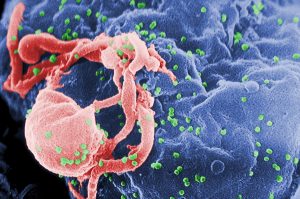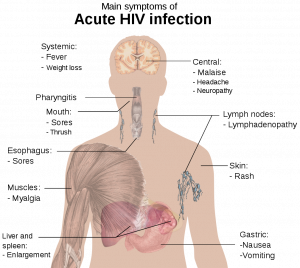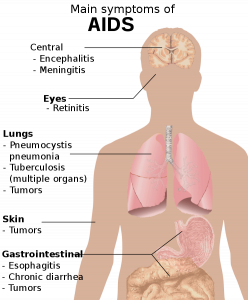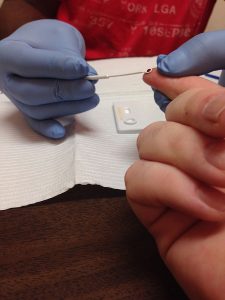What Is HIV?
HIV (human immunodeficiency virus) is the virus that causes AIDS (acquired immunodeficiency syndrome). HIV can damage or even kill the cells of the body’s immune system. Over time, this harms the body’s ability to fight infections and certain cancers. People diagnosed with AIDS may get life-threatening diseases called opportunistic infections, which are caused by things such as viruses, bacteria, or fungi. These infections do not usually make healthy people sick. Those with HIV/AIDS are also at an increased risk of developing certain cancers, neurological disorders, and a variety of other conditions.
Simply put, HIV weakens the body’s immune system over time. If HIV progresses to AIDS, someone can catch a seemingly minor infection that most people would be able to fight off. Someone with AIDS might die from this opportunistic infection.

A few types of HIV exist. Both HIV-1 and HIV-2 can infect humans. Several strains of each type exist. Most people are only infected with one type of the virus, usually HIV-1. HIV-1 is more the most infectious of the two.[2] Although rare, some people can become infected with more than one strain of HIV.
How Common Is HIV and AIDS?
The first case of HIV was reported in 1981. Between then and 2006, people in the United States reported more than 980,000 diagnosed AIDS cases to the Centers for Disease Control and Prevention (CDC). The CDC estimates that more than one million people in the U.S. may be infected with HIV. The CDC also estimates that as many as 250,000 of these people may not know that they are infected. This means that they can unknowingly pass on the virus to others. This is why proper HIV testing is so important.
How Is HIV Spread?
HIV is spread most commonly in these ways:
- By having sex with an infected partner. The virus can enter the body through the lining of the vagina, vulva, penis, rectum, or mouth during sex. That’s right: more than just vaginal or anal sex can spread this infection.
- Unsafe sexual practices. Not using condoms, re-using condoms, using condoms incorrectly, having multiple partners, and not talking about sexual history and health can all increase the risk of getting not just HIV, but other STDs.
- Through contact with infected blood. Certain sexual activities and sharing needles are two ways that HIV can be spread through blood. Decades ago, blood was not screened for evidence of HIV infection. Because of this, some people got HIV after receiving blood transfusions from an infected donor. Today, proper blood screening and heat treatment makes the chance of getting HIV from blood transfusions extremely small.
- By sharing needles or syringes. Needles or syringes can become contaminated with infected blood. Sharing infected items means someone can contract the virus. It is rare, however, for a patient to give HIV to a health care worker or vice-versa by accidental sticks.
- During pregnancy or birth. Approximately one-quarter to one-third of all untreated, HIV-positive pregnant women will pass the infection to their babies. Infected mothers can also transmit HIV to their babies during breastfeeding. There are, however, ways to reduce the risk of an HIV-positive mother passing on the infection to her child. For example, a mother can take the drug AZT during pregnancy. Studies show that this drug significantly reduces the chances of the child becoming infected. Combined with AZT, a c-section delivery can reduce the chances of the baby being infected to a rate of roughly one percent.
- Already having a sexually transmitted disease. Common STDs include syphilis, genital herpes, chlamydia, gonorrhea, and bacterial vaginosis (BV). They appear to make people more susceptible to contracting HIV during sex with infected partners.

Go here for more information on how to have safer sex.
HIV Signs and Symptoms
Acute Illness
HIV initially causes an acute (new) illness. This acute illness can cause either nonspecific or flu-like symptoms. These symptoms can include fatigue, headache, fever, and enlarged lymph nodes. Some people do not show any noticeable symptoms. As signs occur externally, don’t forget that a lot is going on internally as well.
During this time period, the HIV virus is present in large numbers and travels throughout the body. HIV infects specific immune cells, including CD4 T-cells (or helper T cells). Then, the virus slowly begins to decrease immune cells’ numbers. The virus sets up house in places like the brain and lymph nodes. HIV will linger even during future drug treatment. In other words, there is no official cure for HIV or AIDS.

After Acute Illness
The body will produce antibodies against the virus. This is a response to the initial HIV infection. In most people, the initial symptoms go away after a short time period. After this time period, someone can appear healthy for years or even decades. However, just because someone isn’t outwardly showing symptoms doesn’t mean that the HIV virus isn’t working behind the scenes. After initial symptoms disappear, HIV will still replicate and destroy CD4 T-cells. In this way, HIV can eventually compromise an immune system to the point that new symptoms emerge. These symptoms can be persistently enlarged lymph nodes, weight loss, sweating, recurrent yeast infections, fever, herpes infections, rashes, and memory loss or difficulty concentrating.
Children Born with HIV
In children who are infected with HIV at or before birth, symptoms may emerge within a couple of years. They may have delayed development and be frequently ill.
When Does AIDS Develop?
AIDS refers to the most advanced stages of HIV infection. According to the CDC, AIDS is diagnosed either:
- when CD4 T-cell count drops below 200, or
- when someone has HIV and develops an AIDS-related illness, such as tuberculosis or pneumonia.
In people with AIDS, opportunistic infections are often severe and can be fatal. This is because the immune system is so damaged by HIV that the body cannot fight off certain bacteria, viruses, fungi, and parasites.
Infections common in people with AIDS cause symptoms such as:
- coughing and shortness of breath
- seizures and lack of coordination
- difficult or painful swallowing
- mental symptoms, such as confusion and forgetfulness
- severe and persistent diarrhea
- fever
- vision loss
- nausea, abdominal cramps, and vomiting
- weight loss and extreme fatigue
- severe headaches
- coma

HIV Testing

Types of HIV Tests
A few types of HIV tests are available. HIV testing most often uses blood samples. Rapid HIV blood test results can be delivered quickly, many in under 20 or 30 minutes. Since most rapid tests check for antibodies, the CDC says it could be up to 90 days after exposure before these tests can pick up on antibodies.[3] Mouth swab tests are also available.
What Is the Average HIV Testing Window Period?
HIV testing accuracy greatly depends on how soon after your potential exposure you get tested. Testing right away won’t be very useful. Like other infections, HIV won’t immediately show up during screening; it will need time to become detectable.
The type of test you take will determine how soon after exposure you can get reliably tested. The HIV detection period for a nucleic acid test (NAT) is between 10 and 33 days. For an antigen/antibody test—where a lab uses blood drawn from a vein—the window is 18 to 45 days. For most rapid and at-home antibody tests, the period is 23 to 90 days.[3]
The best course of action is to speak with a licensed medical professional. They should be able to give you a better idea if you are testing too soon or not.
Where to Get HIV Testing
Many locations offer STD testing services, including HIV testing. You can find HIV testing centers here.
Because having one STD puts someone at risk for others, it is recommended to check for multiple infections. A full STD panel can check for multiple STDs, including HIV.
[2] Gilbert, P. B., McKeague, I. W., Eisen, G. , Mullins, C. , Guéye‐NDiaye, A. , Mboup, S. and Kanki, P. J. (2003), Comparison of HIV‐1 and HIV‐2 infectivity from a prospective cohort study in Senegal. Statist. Med., 22: 573-593. doi:10.1002/sim.1342
[3] CDC. (Updated 31 October 2018). HIV/AIDS Testing. Retrieved from https://www.cdc.gov/hiv/basics/testing.html
***”HIV Testing – Everything You Need to Know” or other resources on this site are not a substitute for professional medical information or advice. Any health questions or concerns should be directed to a licensed professional.




